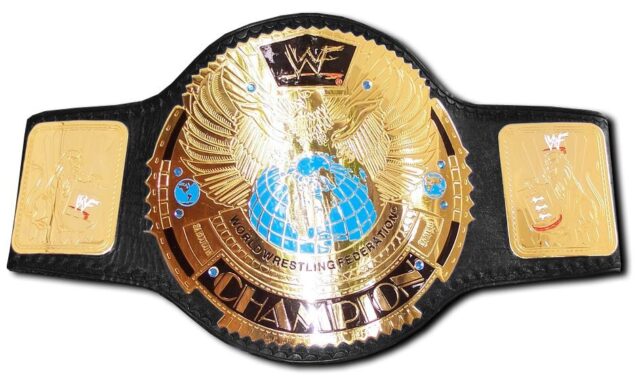In the world of professional wrestling, championship belts are not just pieces of jewelry; they are symbols of prestige, power, and success. Among these iconic titles, the World Wrestling Federation (now known as WWE) Championship Belt has stood out as one of the most recognizable and coveted prizes in the industry. The story behind this legendary belt’s design and the role of the golden eagle in its creation is a fascinating tale that intertwines artistry, innovation, and the rich history of professional wrestling.
The Birth of the WWF Championship Belt
The WWF Championship Belt, like many wrestling belts, has undergone several design changes over the years. It all began in the early 1960s, when the World Wide Wrestling Federation (later renamed the World Wrestling Federation and now WWE) sought to establish a distinct and awe-inspiring symbol of its heavyweight champion’s supremacy.
Before the iconic WWF Championship Belt, champions were often presented with a simple leather strap adorned with brass plates, displaying the promoter’s name and the wrestler’s name wwf championship belt. These belts were basic, functional, but lacked the grandeur that would later become synonymous with the WWF Championship.
The Golden Eagle’s Role
The turning point in championship belt design came in 1982 when a young and talented craftsman named Reggie Parks was commissioned to create a new championship belt for the WWF. Reggie Parks was no stranger to designing wrestling belts, having crafted numerous regional championships before.
Parks, along with WWF executives, embarked on a mission to create a championship belt that would truly stand out. They wanted it to be unique, representative of the grandeur and prestige of the title it would adorn. This is where the story of the golden eagle takes flight.
Parks, drawing inspiration from the eagle as a symbol of strength and dominance, decided to feature a golden eagle prominently on the championship belt. The eagle’s wingspan would stretch across the central plate, making it a breathtaking focal point. This design choice was not just an aesthetic decision; it was a symbolic one.
The golden eagle, with its outstretched wings, represented the essence of a wrestling champion. It signified power, authority, and the ability to soar above the competition. The choice of gold for the eagle and other elements added a touch of opulence, making it clear that the WWF Championship was not just another title but a symbol of wrestling excellence.
Crafting the Masterpiece
The process of creating the WWF Championship Belt was no small feat. Reggie Parks collaborated with skilled artisans to bring his vision to life. The central plate, adorned with the golden eagle, was meticulously carved and detailed by expert craftsmen. The eagle’s feathers and features were meticulously etched into the metal, creating a lifelike and awe-inspiring presence.
The belt’s leather strap was not overlooked either. Craftsmen selected the finest leather and added exquisite tooling and detailing to match the grandeur of the central plate. The result was a championship belt that was not just a symbol of victory but a work of art in its own right.
In 1983, the finished product was unveiled to the wrestling world, and it was an immediate hit. The golden eagle, perched majestically on the central plate, exuded a regal and imposing aura, befitting a title of such magnitude. This championship belt became the physical representation of a wrestler’s journey to the top of the wrestling world.
A Legacy of Excellence
The WWF Championship Belt, with its golden eagle centerpiece, would go on to grace the waists of some of the most legendary wrestlers in the history of the sport. Names like Hulk Hogan, Randy Savage, The Rock, Stone Cold Steve Austin, and John Cena all held this title, and each time they wore it, the legacy of the golden eagle design was enhanced.
Over the years, the WWF Championship Belt continued to evolve, with subtle design changes, but the golden eagle remained a constant, a reminder of the title’s rich history and tradition. Its presence on the championship belt served as a tribute to the wrestlers who had held the title and the fans who had cheered for them.
Impact Beyond Wrestling
The impact of the golden eagle design was not limited to the wrestling ring. It had a profound influence on the world of sports and entertainment. Championship belts, once seen as utilitarian accessories, became objects of desire for fans and collectors alike. The WWF Championship Belt, with its iconic golden eagle, inspired other wrestling promotions to invest in creating visually stunning and meaningful championship titles.
Beyond wrestling, the golden eagle’s influence extended into popular culture. The belt appeared in movies, television shows, and even video games, cementing its status as an iconic symbol of wrestling excellence.
The Evolution of Wrestling Belts
In 2002, the WWF underwent a significant rebranding and became World Wrestling Entertainment (WWE). With the new name came a new logo and a rebranding of their titles professional wrestling championship. The WWF Championship Belt, with its golden eagle, was eventually retired and replaced by the WWE Championship, which featured a distinctive logo in the center.
While the WWF Championship Belt evolved and changed, the legacy of the golden eagle design lives on. It remains a beloved and cherished piece of wrestling history, an emblem of an era when wrestling belts were more than just props; they were works of art.
In Conclusion
The story behind the golden eagle and the design of the WWF Championship Belt is a tale of creativity, symbolism, and the evolution of professional wrestling. The decision to feature a golden eagle as the centerpiece of the championship belt was a stroke of genius that elevated the title to new heights of prestige and grandeur.
The golden eagle represented more than just a bird; it symbolized the strength, dominance, and excellence required to become a champion. It left an indelible mark on the wrestling world and continues to be celebrated by fans and collectors to this day.
While the WWF Championship Belt may have evolved and changed over the years, its legacy, and that of the golden eagle, will forever be etched in the annals of wrestling history as a symbol of excellence and the pursuit of greatness in the squared circle.




